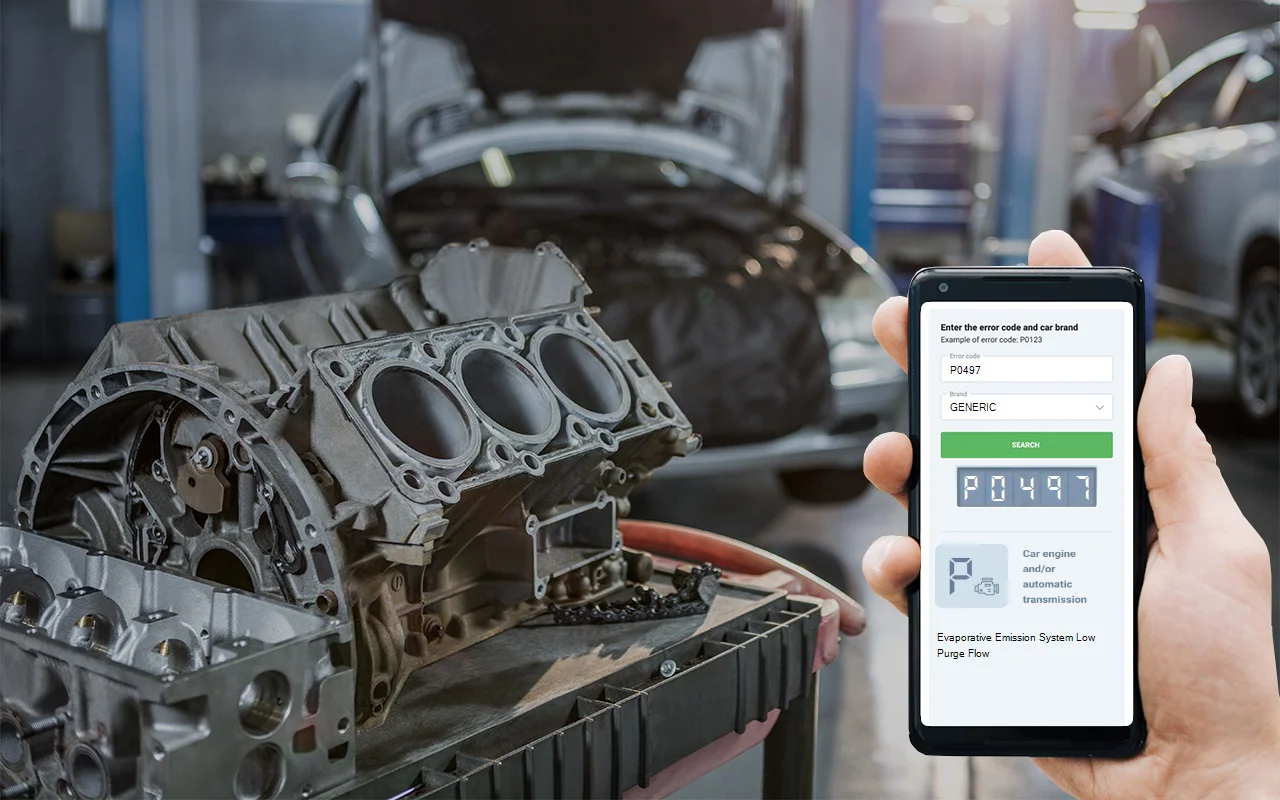Let me break down what code P0497 actually means for your vehicle. This code stands for “Evaporative Emission System Low Purge Flow.” In plain English, your car’s onboard computer (the PCM) has noticed that the system responsible for capturing and burning off fuel vapors-the EVAP system-isn’t moving those vapors into the engine as it should. The EVAP system’s job is to trap gasoline fumes in a canister and, when the time is right, send them into the engine to be burned. The purge valve is the gatekeeper here, and if it’s not letting enough vapor through, or if something else is blocking the flow, the computer sets this code. So, P0497 is all about the EVAP system not purging enough vapor, which can affect emissions and even how your car runs.
DTC P0497
Causes and dtc P0497
From experience, I can tell you that most of the time, P0497 pops up because of a handful of usual suspects. Here’s what I see most often:
- A faulty EVAP purge solenoid or valve-these can stick or fail electrically.
- A bad EVAP pressure sensor, which can send the wrong signals to the computer.
- Restricted or clogged EVAP canister or vent-sometimes debris or charcoal breaks down inside.
- Vacuum lines or hoses that are cracked, pinched, or collapsed, cutting off the flow.
- Electrical issues, like a short or open circuit at the purge solenoid.
It’s best to start with the basics and work your way up, since a lot of these issues are pretty common and can be checked without fancy tools. This issue is also common on Honda and other makes.
Symptoms and P0497 engine code
If your car’s got a P0497 code, you’ll probably notice a few things. The most obvious is the check engine light coming on. You might also catch a whiff of fuel from time to time, especially after you park. Sometimes, you’ll hear a hissing or vacuum leak sound coming from under the hood. Another thing to watch for is rough or uneven idling-your engine might not run as smoothly at stoplights. These symptoms can be annoying, and they’re your car’s way of telling you something’s not right with the EVAP system.

Diagnosis and P0497 code
Here’s how I usually tackle a P0497 code, step by step. First, I always start with a visual inspection-look for any obvious damage or disconnected hoses around the EVAP system, especially the purge valve and canister area. Check all the vacuum lines for cracks, splits, or loose connections. Don’t forget to inspect the electrical connectors at the purge solenoid and pressure sensor for corrosion or broken wires. Next, I use a scan tool to command the purge valve on and off, listening for a click and feeling for vacuum at the line. If there’s no change, the valve might be stuck or the circuit could be open. If everything looks good so far, I’ll check the EVAP canister for blockages or signs of charcoal breakdown. Sometimes, a smoke machine is needed to find hidden leaks or restrictions, but you can also try gently blowing air through the lines to see if they’re clear. If you’re not comfortable with these steps, it’s better to have someone assist you, since the EVAP system can be tricky to access on some vehicles. The obd p0497 scan tool can help pinpoint the source of the problem.

Common Mistakes and P0497 trouble code
One thing I see a lot is folks jumping straight to replacing the purge valve without checking the hoses or wiring first. Another common mistake is overlooking a cracked or collapsed vacuum line-these can be hard to spot but cause big problems. Some people also forget to check the EVAP canister itself for blockages. Skipping the basics can lead to wasted time and money, so always start simple before replacing parts.

Seriousness and P0497
Honestly, this isn’t something you want to ignore. While it might not leave you stranded right away, a faulty EVAP system can lead to increased emissions, poor fuel economy, and even engine performance issues over time. If left unchecked, raw fuel vapors can escape, which is both a fire hazard and bad for your health. Plus, if the purge valve sticks or the canister gets clogged, it can eventually cause problems with other parts like the fuel tank or even the engine itself. Things can go south quickly if overlooked, so don’t put this off for later.
Repair and obd2 code P0497
In cases like this, the most reliable fixes are:
- Replacing a faulty purge valve or solenoid if it’s not operating correctly.
- Swapping out a bad EVAP pressure sensor if it’s giving false readings.
- Repairing or replacing any damaged, cracked, or collapsed vacuum hoses.
- Cleaning or replacing a clogged EVAP canister or vent.
- Fixing any wiring or connector issues at the purge solenoid or pressure sensor.
Once repairs are done, I always clear the code and run the system test again to make sure everything’s working as it should.
Conclusion
To sum it up, code P0497 means your car’s EVAP system isn’t moving fuel vapors like it should, which can lead to bigger problems if ignored. It’s not the most dangerous code out there, but it’s definitely not one to put off-especially since it can affect your engine and emissions. The best approach is to start with a thorough inspection of hoses, valves, and sensors, then move on to repairs as needed. Acting quickly and methodically is the surefire way to keep your car running clean and smooth.
- Causes and Fixes P0497 Code: Evaporative Emission System Low Purge Flow

- 5 Things That Can Happen If your CODE Is P0497 on your Honda Civic

- P0497 EVAP PURGE SOLENOID REPAIR AND VERIFICATION : 2005 HONDA ACCORD V6 J SERIES

- P0497 Evaporative Emission System Low Purge Flow 🟢 Trouble Code Symptoms Causes Solutions





